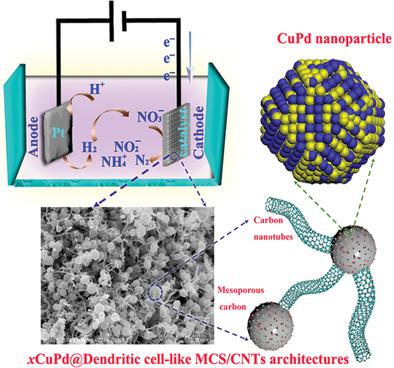Our official English website, www.x-mol.net, welcomes your feedback! (Note: you will need to create a separate account there.)
Dendritic Cell-Inspired Designed Architectures toward Highly Efficient Electrocatalysts for Nitrate Reduction Reaction.
Small ( IF 13.3 ) Pub Date : 2020-06-25 , DOI: 10.1002/smll.202001775 Hui Xu 1 , Jing Wu 2 , Wei Luo 1 , Qin Li 3 , Weixian Zhang 4 , Jianping Yang 1
Small ( IF 13.3 ) Pub Date : 2020-06-25 , DOI: 10.1002/smll.202001775 Hui Xu 1 , Jing Wu 2 , Wei Luo 1 , Qin Li 3 , Weixian Zhang 4 , Jianping Yang 1
Affiliation

|
Electrocatalysis for nitrate reduction reaction (NRR) has recently been recognized as a promising technology to convert nitrate to nitrogen. Catalyst support plays an important role in electrocatalytic process. Although porous carbon and metal oxides are considered as common supports for metal‐based catalysts, fabrication of such architecture with high electric conductivity, uniform dispersion of nanoparticles, and long‐term catalytic stability through a simple and feasible approach still remains a significant challenge. Herein, inspired by the signal transfer mode of dendritic cell, an all‐carbon dendritic cell‐like (DCL) architecture comprising mesoporous carbon spheres (MCS) connected by tethered carbon nanotubes (CNTs) with CuPd nanoparticles dispersed throughout (CuPd@DCL‐MCS/CNTs) is reported. An impressive removal capacity as high as 22 500 mg N g−1 CuPd (≈12 times superior to Fe‐based catalysts), high nitrate conversion (>95%) and nitrogen selectivity (>95%) are achieved under a low initial concentration of nitrate (100 mg L−1) when using an optimized‐NRR electrocatalyst (4CuPd@DCL‐MCS/CNTs). Remarkably, nitrate conversion and nitrogen selectivity are both close to 100% in an ultralow concentration of 10 mg L−1, meeting drinking water standard. The present work not only provides high electrocatalytic performance for NRR but also introduces new inspiration for the preparation of other DCL‐based architectures.
中文翻译:

树突状细胞启发设计的架构,用于高效硝酸还原反应的电催化剂。
硝酸盐还原反应(NRR)的电催化最近被认为是将硝酸盐转化为氮的有前途的技术。催化剂载体在电催化过程中起重要作用。尽管多孔碳和金属氧化物被认为是金属基催化剂的常见载体,但是通过简单可行的方法来制造具有高电导率,纳米颗粒均匀分散和长期催化稳定性的结构仍然是一项重大挑战。在此,受树突状细胞信号传输模式的启发,全碳树突状细胞状(DCL)架构包括通过束缚碳纳米管(CNT)连接的介孔碳球(MCS)和分散在各处的CuPd纳米粒子(CuPd @ DCL-MCS / CNTs)。当使用低浓度硝酸盐(100 mg L -1)时,可实现-1 CuPd(比铁基催化剂高约12倍),高硝酸盐转化率(> 95%)和氮选择性(> 95%)。优化的NRR电催化剂(4CuPd @ DCL-MCS / CNT)。值得注意的是,在10 mg L -1的超低浓度下,硝酸盐转化率和氮的选择性都接近100%,符合饮用水标准。目前的工作不仅为NRR提供了高电催化性能,而且为其他基于DCL的体系结构的制备提供了新的启示。
更新日期:2020-07-28
中文翻译:

树突状细胞启发设计的架构,用于高效硝酸还原反应的电催化剂。
硝酸盐还原反应(NRR)的电催化最近被认为是将硝酸盐转化为氮的有前途的技术。催化剂载体在电催化过程中起重要作用。尽管多孔碳和金属氧化物被认为是金属基催化剂的常见载体,但是通过简单可行的方法来制造具有高电导率,纳米颗粒均匀分散和长期催化稳定性的结构仍然是一项重大挑战。在此,受树突状细胞信号传输模式的启发,全碳树突状细胞状(DCL)架构包括通过束缚碳纳米管(CNT)连接的介孔碳球(MCS)和分散在各处的CuPd纳米粒子(CuPd @ DCL-MCS / CNTs)。当使用低浓度硝酸盐(100 mg L -1)时,可实现-1 CuPd(比铁基催化剂高约12倍),高硝酸盐转化率(> 95%)和氮选择性(> 95%)。优化的NRR电催化剂(4CuPd @ DCL-MCS / CNT)。值得注意的是,在10 mg L -1的超低浓度下,硝酸盐转化率和氮的选择性都接近100%,符合饮用水标准。目前的工作不仅为NRR提供了高电催化性能,而且为其他基于DCL的体系结构的制备提供了新的启示。


























 京公网安备 11010802027423号
京公网安备 11010802027423号